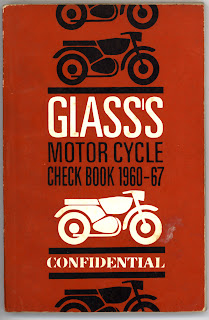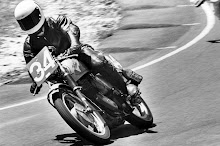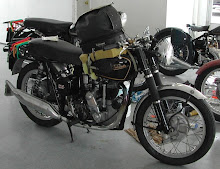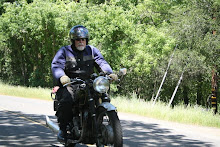
Everyone knows that, for years, the KTT Velocette was unique in being the nearest possible thing to a genuine T.T. model which was available to the public. It was, in fact, designed and intended for road racing, and this must be remembered when considering the following notes.
Looking at all the parts neatly laid out on the sheets of brown paper, I was at a loss to know where to begin. Finally, after discussing the point with Messrs. Percy Goodman and Harold Willis-now, unhappily the late Harold Willis- I decided to start at the top and work down, yet in actual practice my first question dealt with the cylinder barrel. "What are the materials, and how are they mated?"
Rather to my surprise I learned that the silicon-aluminium-alloy jacket with its very deep radiating ribs, was "cast on," the nickel cast-iron barrel, with its corrugated outer wall, being heated and placed in the mould before the alloy was poured.
Mr. Willis did not think there was much to choose between this practice and that of pressing-in a liner or shrinking-on a jacket, but actually Velocettes, he said, had had slightly better results with the practice outlined; it prevents the possibility of the liner "creeping."
The head, I gathered, was of heat-treated "Y"-alloy, a metal chosen for its light-weight, strength and high thermal conductivity. The head ribs of the KTT are roughly 9in square in plan view, and the camshaft casing and the boxes for the enclosure of both valves and their double hairpin valve springs are cast with the head, so you can judge the importance of a lightweight material.
Of course, I asked why these huge cooling fins were employed, suggesting that it must be almost impossible for a considerable draught of air to reach the rib roots.
In this matter Mr. Willis told me I was correct, but that careful tests showed that it was of greater importance to get a big cooling surface right out into the draught then to rely on such air as might possibly pass the front wheel, mudguard, fork, frame, etc., reaching the roots of the fins.

That explains the importance of high conductivity, does it not?
Again, he pointed out that the joint between the head and barrel, at the top of the spigot, consisted of a laminated copper washer. Each of the four laminations is about 0.009 in thick, and this arrangement makes a very satisfactory job with direct metal-to-metal contacts throughout.
Internally, the head is approximately hemispherical, the long-reach 14mm plug being placed on high up and screwed directly into the head.
My next question was, "Why do you employ different materials for exhaust and inlet valve seating?"
"A hard aluminium-bronze alloy is used for the exhaust seat, because of the high conductivity of this metal helps to keep the exhaust valve cool and, incidentally, its high co-efficient of expansion helps to maintain good contact with the head casting at high temperatures."For the inlet valve, the seat of which is apt to be damaged by grit, a nickel cast-iron is employed on account of tis hardness."
Pressed-in Seatings
"How are the seatings help in position?" I then asked.
"The head is heated in an electrical furnace to a temperature of 200 degrees C., and the seatings previously mounted on special jigs, are pushed home very quickly. Speed is essential in this process, for as soon as the seatings come in contact with the hot head, they also expand and lock in position."

The pale gold of aluminium-bronze valve guides next caught my eye. The high heat conductivity and high coefficient of expansion, plus the fact that this material is an excellent bearing metal, make it very suitable for the purpose. Add to this, ample lubrication from the cam-box and the very high finish of the valve stems and guides, and I was not surprised to hear that wear at this point is negligible over long periods.
Incidentally, the valve stems work with quite close clearance limits, the actual figures being 0.0015in for the inlet and 0.003in for the exhaust.
"Why is the inlet valve of larger diameter that the exhaust?" Both my mentors answered this question. Perhaps I may summarize their remarks by saying that it is far more difficult to fill a cylinder by atmospheric pressure than to empty it when the piston pushes behind and there is help at certain vital speeds from a specially designed exhaust pipe.
"The valves themselves? Well, the inlet is made of a cobalt-chrome steel having high tensile strength and hard wearing surfaces. It has a throat diameter of 1 9/16in, an the stem is reduced to the smallest possible diameter consistent with safety, so as to reduce port obstruction. K.E.965 steel was chosen for the exhaust valve because it retains great strength at the very high temperatures at which it is called upon to work.
Valve Timing
The port diameter of the exhaust valve is 1 7/16in, and the stem is approximately 1/16in larger than that of the inlet, and the lift of both valves is 3/8in. Both have moderately recessed heads, but whereas the end of the inlet stem is hardened, the material of the exhaust is unsuited for this purpose, so a hardened end-cap is used.
I asked if the valve timing were a secret, but it was given me without the slightest hesitation. Checked with a tappet clearance of 0.020in in each case, the timing is as follows : inlet opens 55º BTDC, and closes 65º ABDC.; exhaust opens 75º BBDC. & closes 45º ATDC.
One hundred degrees overlap. Think of it! That ought to get the inlet gas column moving and ensure that the valve are well open when they will do most good!
The correct running tappet clearances are: inlet 0.0015in, exhaust 0.025in.
Even the details of the valve spring cup and collect are of unusual interest. It was pointed out that the groove in the top of the valve stem is extremely shallow in order to reduce the strength of the stem as little as possible. To make up for this the split collett is so designed as to grip the stem, and under the wedging action of the spring cup this grip is almost sufficient without the groove.
 Free to Rotate
Free to Rotate
The item which corresponds to the usual spring cup (and is described as such above) does not, in fact, form a direct thrust face for the hairpin springs, the looped ends of which are hooked on to a separate steel spring abutment, loosely mounted round the "spring cup." Thus, at the expense of a little extra reciprocating weight, the valve is free to rotate, a most desirable feature.
At their lower ends the valve springs are tucked into longitudinal holes drilled in a steel plate which surrounds the upper part of the valve guides. And these plates have at each end, a tapped hole to carry the fulcrum of a spring removing tool.
"What spring pressures are necessary for this engine?" I asked.
"Measures with the valve closed, a pressure of 110lb, plus another 25lb for the return spring on the rocker, the latter an important point which we will discuss when we get there."
"Does the total enclosure of the valve gear cause any kind of trouble in the way of overheating?"
"No, the valve boxes have a large external area exposed to the draught and the interior is cooled by a liberal circulation of oil."
"Some years ago you used a two-cam-shaft racing engine," I said. "Why, in the this engine, have you reverted to the single-camshaft type?"
"I was about to mention that very point," said Mr Percy, " as ti is a matter of some historical interest. The twin-camshaft job, in spite of its theoretical advantages, presented certain practical difficulties. (Since overcome as recent Velocette racing engines have demonstrated.-Ed) It was difficult to provide reasonably accessible tappet adjustment, and to enclose the mechanism-a point which, as you know, we consider to be important. Further, for the first time we had trouble with the vertical shaft drive, which could be traced indirectly to the upper works of the valve gear."

Mr. Willis continued: "After much experiment we found that the best of all round results could be obtained from a single-camshaft engine if the rockers could be held in constant contact with the cam. This led to the powerful hairpin rocker return spring which you are examining. At first this caused scoring and rapid wear of the rocker heels and cams, and we found it necessary not only to provide a jet of oil directly on to the point of contact between cam and rocker, but also to face the heel of the rocker with Stellite. These precautions have been completely successful.
Floating Bushes
On inquiry, I found that these rockers are made from stampings of air-hardening, nickel-chrome steel of 100-ton tensile test. Between each rocker and its massive eccentrically mounted pivot-pin is a bronze floating bush.
"Why are the cams made separate from their shaft?"
"Well, the cams, which are designed to give constant valve acceleration and deceleration are of a straight carbon-steel, deeply cased, and have 1 per cent carbon in the case. The shaft is of 3 per cent nickel steel, case-hardened so as to form a track for the driving-side roller bearing. The cams are pressed and keyed on to the shaft. The rollers on the drive side are caged and a ball-bearing on the other end of the shaft takes the end thrust from the bevel gears."
"What about the vertical-shaft drive?"
"Most of it is standard, including the upper pair of bevels. The crown bevel is bolted to its back place by four bolts, and the bolt holes are elongated to provide a half tooth adjustment for timing. The lower bevels have been strengthened to withstand the extra strains imposed by high speed and heavy valve springs."
"Why the lower bevels and not the upper ones?"
"Because the shape of the small-diameter bevels of approximately bevels of not so favourable to tooth strength."
"I note you retain the hunting tooth."
"Yes, the odd teeth in the vertical-shaft drive distribute the loading as evenly as possible. The vertical-shaft bevels are mounted in bronze journal bushes, the thrust being taken on the end faces. Steel rings are lightly pressed on to the shafts to locate the bevels length-wise in their bearings. There is an Oldham coupling of oil-hardened nickel-chrome steel between each bevel shaft and the solid steel coupling shaft. This coupling shaft is mounted in plain bearings in tis enclosing tube, and the tube is held at each end by asbestos-packed gland-nuts, and although it appears to be quite rigid, there is just a trace of intentional flexibility in the mounting."
The unusually narrow aluminium-alloy crankcase is noticeable without need of questions, and the single-row caged roller bearings on each side are supported directly under the massive walls in which the main
strength of the crankcase lies. The only additional stiffening is provided by shallow webs on the outside of the drive side. As in other Velocette models , the primary drive lies inside the final drive, and therefore the engine spoket is close up to the main bearing. Thus, there is very little overhang and no need for a multiplicity of crank bearings.
 Immense Rigidity
Immense Rigidity
A glance at the compact and immensely rigid crank unit with its single-row big-end and comparatively narrow (13/16in) flywheels, also at the smooth, web-less interior of the crankcase, shows how that effect of slimness is attained, but here more questions were necessary.
"What are the flywheels made of?"
"Heat-treated carbon steel."
"Why heat-treated?"
"To prevent stretch in the shaft holes."
"How are the crank axles fixed in the flywheels?"
"Just pressed in, and located the pin.”
"The pin is really a screw lying parallel with the shaft, partly in the shaft and partly in the flywheel bass. These shafts, of 3 per cent nickel steel, are very slightly tapered so that the inner races of the main bearings are securely locked when pushed home. The outer races are shrunk in to the crankcase, so that they also are firmly held."
Then I asked about the massive crank-pin, which adds so materially to the rigidity of the crank unit. It is made of nickel-chrome steel, case hardened to form the inner race of the big-end bearing. The main diameter is 1 3/8 in, and the ends are very slightly tapered and pulled into the flywheels against wide shoulders. The nuts which fix it are of heat-treated nickel steel.
Rollers of 9/16in x 3/16in are employed in the big-end bearing. These rollers are located in a Duralumin cage, the bars of the cage being relieved on their inner surface so that the only end rings of the cage bear on the crankpin.
The reason for this is that the Duralumin cage is apt to wear the hardened crankpin, and the relief of the bars prevents damage to the roller track. This, of course, is a fact, though it may seem hard to believe that more wear is caused by the light-alloy cage than the heavily loaded rollers. The outer race of the bearing is pressed into the connecting rod big-end and a bronze bush into the small-end.
The massive forged connecting rod is made form an oil hardening nickel-chrome steel, heat-treated to about 80 tons tensile. "Of course," said Mr. Willis, "we could use a steel with higher tensile strength, but tensile strength is not the only necessity, for the great toughness is also required. The rod is machined all over and polished on the outside. This is not only useful for removing surface scale and weight, but also tends to reveal surface cracks or flaws."
Of case-hardened nickel-chrome steel, the gudgeon pin is no less than 13/16in diameter; it is hollow and is taper bored at the ends to reduce weight. It floats in the little-end of the connecting rod, and is retained in the piston bosses by spring-wire circlips. As was pointed out, the outer extremities of the gudgeon pin are so chamfered that any tendency for the pin to move endways tens to also to jamb the circlips in their grooves, rather than to displace them.In order to provide the standard compression ratio of approximately 10.9 to 1, the piston head must be steeply domed. It is! So much so, indeed, that circular pockets are formed in the sides of the dome to clear the valve heads.
The skirt is of slipper form, and the whole is made of heat treated "Y"-alloy, sand-cast,
"Why sand-cast?" I asked.
"Because it has given us better results that way," was the reply.

There are small, vertical ribs from the gudgeon-pin bosses upwards, and there is a circular rib at the level of the boss centres for maintaining the shape of the slippers. Two narrow pressure rings of Wellworthy "Themocrom" (heat-formed, not hammered) and a slotted scraper ring are fitted.
"Each engine, individually, is adjusted by shims under the cylinder base so that the cylinder head capacity is 35c.c.," said Mr. Willis.
This 348c.c. engine develops 27 b.h.p. at 6,500 r.p.m. It may be run at 7,000 r.p.m. in the normal course of events, and may be run with safety up to 7,500 r.p.m. for short periods, and will run up to 8,000, though this is considered to be beyond the limits of reasonable safety.
 of KTTs amongst other things.
of KTTs amongst other things. He raced, largely without major success but eventually obtained some support from a motorcycle dealer in 1947, one George Bryant known as “the Rider Agent”.
He raced, largely without major success but eventually obtained some support from a motorcycle dealer in 1947, one George Bryant known as “the Rider Agent”. The other shows Les , again in 1939 from a small sepia print I acquired years back and judging by his leather coat blown open, it was quite windy...
The other shows Les , again in 1939 from a small sepia print I acquired years back and judging by his leather coat blown open, it was quite windy...























































